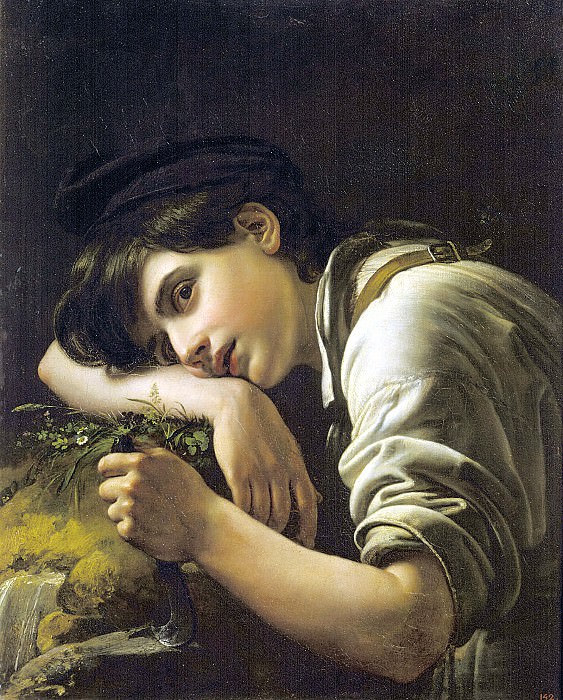Young gardener. 1817 Oil on canvas. 62h49, 5 RM Orest Adamovich Kiprensky (1782-1836)
Orest Adamovich Kiprensky – Young gardener. 1817 Oil on canvas. 62h49, 5 RM
Edit attribution
Download full size: 1600×1992 px (0,7 Mb)
Painter: Orest Adamovich Kiprensky
Orest Adamovich Kiprensky was a debutant of romantic exploration in Russian painting and a great portraitist. Constantly in creative search, he dreamed of painting large-scale works based on historical and mythical stories. His technique and style have been compared to that of Rubens, sometimes even mistaking Kiprensky’s own work for that of the Flemish painter. His contemporaries called him the Russian Van Dyck.
Description of the painting "The Young Gardener" by Orest Kiprensky
Orest Adamovich Kiprensky was a debutant of romantic exploration in Russian painting and a great portraitist. Constantly in creative search, he dreamed of painting large-scale works based on historical and mythical stories. His technique and style have been compared to that of Rubens, sometimes even mistaking Kiprensky’s own work for that of the Flemish painter.
His contemporaries called him the Russian Van Dyck. The portraits brought him the greatest success. His works in this genre of drawing were indeed amazing and inimitably beautiful, bringing satisfaction and solace to the "rebellious soul" of the artist himself.
He was always drawn to the theme of painting a person. Inspired by the attempt to penetrate and reveal the mystery of someone else’s life. At a certain moment the portrait becomes a central trend in the work of Oleg Kiprensky. He was the first to begin to develop a portrait composition, in which the social affiliation of the model loses its original meaning. The artist puts the interest in the personality of the person, the value of the person himself on the first place.
One of his famous portraits is The Young Gardener, or The Italian Gardener, which he painted in 1817. The creation of the painting coincided with the artist’s stay in Italy. At that time it was a country of eternal beauty, poetry and harmony with nature. All these characteristics are reflected in such a direction of Italian painting as the "Italianizing genre". Orest Adamovich, studying the works of Italian artists, perfectly reflected in this picture the first attempt to work in this style. О. Kiprensky managed to avoid blind imitation and bring his own, personal touch. He opened Russia to the Italians and was honored to receive a private commission from the Uffizi Gallery.
A lovely sweet boy whose pose is full of peaceful apathy. The latter reflects a complex compositional technique new to the artist, based on a circle. The gardener’s gaze is fixed on space, distracted and indifferent. Flowers pressed with his hand and a small stream of water gushing from the stone bring serenity and peace. New coloristic effects, engraved outlines, and the finest "enamel" elaboration are observed, giving the skin a smoothness and radiance. The image of the young gardener breathes joy and innocence.
Кому понравилось
Пожалуйста, подождите
На эту операцию может потребоваться несколько секунд.
Информация появится в новом окне,
если открытие новых окон не запрещено в настройках вашего браузера.
You need to login
Для работы с коллекциями – пожалуйста, войдите в аккаунт (open in new window).
















COMMENTS: 2 Ответы
Потрясающий цвет кожи – просвечивает румянец, картина завораживает не могу оторваться
Кроме как шедевром эту картину не назовёшь! Спасибо за альбом!
You cannot comment Why?
The background is dark and somber, with the light focused on the subject, emphasizing their delicate features and contemplative pose. The gaze of the young gardener is directed downwards and outwards, suggesting a moment of introspection or perhaps weariness. The presence of wildflowers and the gardening tool clearly indicate the titles theme of youth and a connection to nature and labor.
The subtexts of the painting can be interpreted in several ways. The tender age of the subject combined with the tools of labor could symbolize the early onset of responsibility or the simple yet profound connection between youth and the natural world. The thoughtful, almost melancholic expression might allude to the burdens of work, the fleeting nature of youth, or perhaps a quiet appreciation for the beauty of the flowers they hold. The dramatic lighting and dark background can contribute to a sense of pathos and highlight the individuals internal world against a more opaque exterior. Its a depiction that balances the innocence of youth with the realities of labor and the quiet contemplation of life.